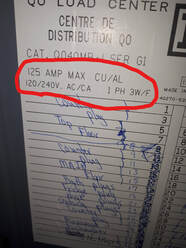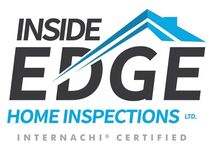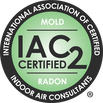Mike's Home Inspector BlogMichael Burfitt |
 If you have ever looked at your electric panel, you might see a label similar to this. If you are like most homeowners, you have no idea what all the circled numbers and letters mean. Let us take a quick look at each one: 125 AMP MAX This is a measure of the maximum amperage rating. Simply put, this is a measure of the flow of electricity. Most modern houses have a 200-amp service although I have seen service as low as 100 amp without issue. There are systems that are smaller than 100 amp but in general, many insurance companies will not insure a home with less than 100 amp mostly due to the fact these are generally older systems and do not meet a modern family's needs. CU/AL This means that this panel can use either copper or aluminum conductors. You may have heard that aluminum wires are a major fire hazard and while that can certainly be true, there are many situations where they may be used safely. Your home inspector should be able to tell you if you have aluminum wiring and if so, whether an electrician should be consulted. 120/240V This is a measure of the voltage (pressure) this system is designed for. Well over 99% of homes in North America use what is known as a split phase system that uses two 120V service wires (120+120=240). While there are some properties that use just one 120V (mostly very old homes or cottages), I have never encountered one in the field. Fun fact: you may have heard that high voltage is very dangerous and while in most cases this is true, there are some ways that getting shocked with high voltage can be perfectly safe. Did you know that a simple static shock can deliver between 20,000 to 30,000 volts? AC/CA This is an acronym for alternating current in both English and French. I could write several essays on alternating vs direct current (DC) and why we receive power as AC yet use DC in most appliances and gadgets but, with the exception of solar systems, nearly every home receives power from the utility as AC and this is a standard designation. 1 PH This refers to the fact that this panel is designed for single phase power. To make a complex concept simple, there are two types of phasing used: single phase and three phase. Almost all homes and small businesses use single phase and three phase is used in large buildings. The way inspectors tell single from three phase power is the number of hot service wires, which brings us to our last point. 3W/F This means that is designed for 3 wires from the utility: 2 hot (usually black and red) and 1 neutral (white) wire that services the home. Three phase systems usually have an extra hot wire (any color except white or green but usually blue) and are extremely rare in homes. Still confused? Let me quickly summarize: the only thing you need to worry about as a new or existing homeowner is the amperage, which usually varies from 100 to 200 (and up) amperes. The rest is standard to nearly every home and any deviation should be investigated by an electrician. |
Archives
July 2024
Categories
All
|
|
Inside Edge Home Inspections Ltd.
Halifax, NS 902-209-9921 [email protected] Proudly Serving the HRM & Central Nova Scotia |

 RSS Feed
RSS Feed

